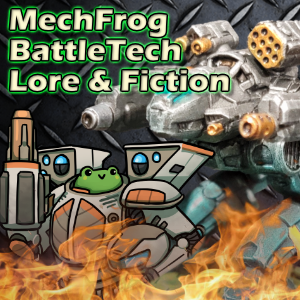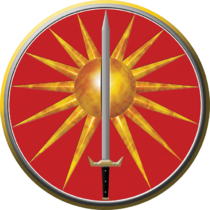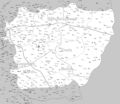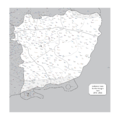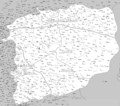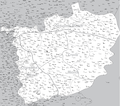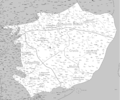Federated Suns
This article needs to be updated with material from Handbook: Major Periphery States, Era Report: 2750, Era Report: 3145, Shattered Fortress. Once these titles clear the Moratorium period, or if they already have, please consider revisiting this article and updating it with the new material. |
| Federated Suns | |
|---|---|
| State Profile | |
| Founding Year | 2317[1] |
| Capital world: | New Avalon |
| Controlled system(s): | 500+ |
| Government | |
| Head of State | President (2317 - 2417) First Prince (2417 onwards) |
| Civilian Intelligence | Ministry of Information, Intelligence, and Operations (MIIO) |
| Military | |
| Commander-in-chief | Supreme Marshal |
| Army | Armed Forces of the Federated Suns (AFFS) |
| Navy | Federated Suns Navy (FSN) |
| Military Intelligence | Department of Military Intelligence (DMI) |
The Federated Suns has traditionally been the most powerful and largest of the Successor States to occupy the Inner Sphere. From their ancestral home of New Avalon, the scions of House Davion have ruled the Federated Suns since its founding by Lucien Davion in 2317. While tracing their family line to French and English nobility of ancient Terra and ruling as constitutional monarchs, the Davions have always positioned themselves and the Federated Suns as champions of liberty and personal freedoms in the Inner Sphere. This view has bred a sense of righteousness in the Davion cause, serving as both a source of strength and weakness during their history.[2][3]
For a time, the Federated Suns joined together with the Lyran Commonwealth to create a new superstate, the Federated Commonwealth, which dominated the Inner Sphere during the thirty-first century. However, internal divisions and other factors eventually led to the Lyran half seceding to form the Lyran Alliance and the FedCom Civil War. While maintaining the Federated Commonwealth name for several years afterwards, the rump state eventually returned to its traditional name as the Federated Suns.
Contents
History[edit]
Founded in 2317, the Federated Suns was the brainchild of the Davion family, an influential noble family of the world of New Avalon. The father of the Federated Suns was Lucien Davion, a master politician and statesman, rose to power partially assisted by the influential function the planet served as the regional breadbasket.[4]
In 2567, the Federated Suns joined the Star League, becoming the fourth member state. The Star League years were relatively quiet, with the Federated Suns working alongside the Star League to ensure a reign of peace and prosperity lasting for hundreds of years.
During the Succession Wars, the Federated Suns fought heavily with the Capellan Confederation and the Draconis Combine.
During the 3024–29 period, a secret pact was formed between the Federated Suns and the Lyran Commonwealth, in addition to the public alliance between Hanse Davion and Katrina Steiner. In 3055, the Federated Commonwealth was officially formed from those two states. The Lyran Commonwealth seceded from the alliance in 3057, beginning the FedCom Civil War. The Federated Commonwealth was officially renamed back to Federated Suns in 3067 by Regent Yvonne, with the conclusion of the FedCom Civil War.
Initially, the turmoil of the Dark Age did not affect the Federation too much, which supplied forces to fight alongside the Republic of the Sphere against the Senate dissidents, under the command of Julian Davion. After the death of Caleb Davion in battle against Draconis Combine forces, Julian Davion became the new First Prince, forcing his speedy return to the Federation. A year after his arrival, the Federated Suns faced one of the greatest crisis in its history: invasions by both the Draconis Combine and Capellan Confederations managing to capture New Avalon, Robinson, and New Syrtis. With the Federated Suns on the brink of extinction, Julian launched Operation CERBERUS in 3147, succeeding in taking New Syrtis, though at great cost.[5]
In 3149, the Republic of the Sphere's Operation ERUPTIO assisted the Suns in recovering Robinson, which left only New Avalon in the Combine's hands, along with the so-called Dragon's Tongue.[6]
Politics[edit]
The Federated Suns (also known as "the Federation" by its citizenry) has changed significantly since its original founding as a loose coalition of worlds coming together for mutual defense and trade. Originally each world sent delegates to serve on a High Council which would choose from among themselves a President, with both sharing equal power. However, the difficulties of carrying out a representative democracy over interstellar distances, combined with the political machinations of the Davion family, led to the Presidency becoming essentially a monarchy which was practically reserved for the Davions.[7][8] Simon Davion formalized this situation in March 2418 by reshaping the nation into five Principalities, also known as Marches, each headed by a Prince and led by a single First Prince; the first such First Prince was Simon Davion himself.[9] Below each Prince was a system of duchies, margraves, counties and baronies and a new class of titled individuals was created, each of whom was subject to appointment by the Prince of his or her respective March. This reform formalized the neo-feudal system that had already been growing throughout the region since the early history of New Avalon.[10] In the wake of the Davion Civil War, Alexander Davion eliminated the other princely positions, leaving the First Prince as sole ruler of the Federated Suns. The aristocratic system of rule which Simon Davion had established remained though, having become firmly established over the previous century with the acceptance of the people.[7][11]
While the nobility hold the levers of power at the national level, planetary and local governments are usually allowed great autonomy in how they run themselves: the majority of planets are based on a parliamentary system similar to that of the former United Kingdom of Terra, while others might adopt anything from democratic communism to full-fledged dictatorship. Though the nobility might technically hold absolute power in the Federated Suns, most nobles are smart enough to recognize that to go against the will of the people will quickly spell their political downfall. As such, so long as taxes are collected and their personal holdings are not in danger, the majority of nobles will not interfere with local government decisions unless absolutely necessary. The only exception are those planets placed under a Military Governorship, whether due to recent rebellion or having been captured from the enemy, or those worlds subject to the War Zone Actions of 2787.[12][13]
The rights of the Federation's citizens are enshrined in its constitution, the original Crucis Pact which created the Federated Suns. Known as the Six Liberties, they are: the right to personal liberty, to own property, to own weapons, to expect fair treatment, to privacy, and to participate in planetary government.[12][14] Such rights are guaranteed by the national government, ensuring that freedom of religion and of expression supersede any laws enforced by local governments.[13] This also includes the right to petition for the removal of a noble who is unworthy of their position, or to engage in direct action to have them removed (which, while not a formal right, is considered a time-honored tradition nonetheless).[15]
First Prince[edit]
The First Prince is the leader of the Federated Suns and the Commander-in-Chief of the Armed Forces of the Federated Suns (AFFS). The First Prince has the right to appoint or dismiss any noble or government official and may rule by decree, though there are some limits when it comes to the rights and freedoms of the nobility and the people. Only a member of House Davion may become a First Prince, but only if they have achieved 20 years of age and have served at least five years in the military. Beyond their official powers, much of the strength of the First Prince lies in House Davion's personal wealth. While official figures are not made public, in 3025 it was believed they owned vast landholds on at least a dozen worlds (including the so-called 'Golden Five') and were major shareholders in at least twenty large corporations.[16][14] The First Prince may also bestow the title of Prince's Champion on any individual, traditionally a senior AFFS Field Marshal who is either a trusted friend or family member, to act with their authority on military and political matters when the First Prince is unavailable. It should be noted that the term "Prince" is gender-neutral in its Federated Suns usage, although both Katherine Steiner-Davion and Yvonne Steiner-Davion styled themselves as the feminized "Princess" in their titles ("Archon-Princess" and "Princess-Regent," respectively).
The First Prince is also surrounded by the Royal Court, a term which refers to two distinct concepts. The first is the physical building complex which surrounds the Royal Palace on New Avalon, in which is housed the Ministries which see to the running of the Federation. The second is the social season held every spring for three months, where nobility and political leaders from across the realm are invited to the Royal Palace to partake in grand balls, game hunts, and some wheeling and dealing.[17][18]
Privy Council[edit]
Created by Alexander Davion as an alternative to the High Council, the Privy Council is a group of the highest advisers to the First Prince and is extremely important in the running of the day-to-day affairs of the state. Acting as an advisory council to the First Prince, the Privy Council was given many of the powers once held by the High Council: recommending military and government appointments, overseeing the running of the state bureaucracy, and determining the line of succession or the appointment of a regent upon the death or retirement of the First Prince.[19][18]
The Privy Council is a small body and most of its members naturally reside on New Avalon, allowing it to react quickly to new events, though when needed members may also empower a deputy to speak on their behalf. From the military are seated the Prince's Champion, the Marshal of the Armies, and the heads of the eight military departments (the directors of the military Marches may also sit as nonvoting advisers). The President and an elected member of the High Council also sits on the Privy Council. Lastly, the Ministers in charge of each of the eight Ministries which oversee the governing of the Federated Suns sits on the Privy Council.[19][18]
High Council[edit]
The High Council was formerly a governing body equal to the President and, for a time, the First Prince of the Federated Suns. Each member world and associate world was represented on the Council with a delegate and from among their members they elected a President to serve until life or impeachment by three-fourths of the High Council.[7] It had the power to appoint representatives to foreign governments, approve treaties and enact laws. As the High Council grew in size, the limitations of interstellar travel and communication made it slow and unwieldy in responding to new events, while the political acumen of the Davion family began to rob it of some of its power. The High Council eventually became nothing more than a rubberstamp for the Davions, until it began to fail even at that task as it became bogged down in parliamentary maneuverings. While most of its powers have since been transferred to the First Prince and the Privy Council, the High Council still acts as a forum to debate policy, put forward recommendations and enact regulatory changes.[17][18]
The Marches[edit]
The internal administrative structure of the Federated Suns has changed several times during its history. In the period prior to the formation of the Capellan Confederation the region within which the various nations and proto-states such as the Sarna Supremacy and Tikonov Grand Union existed was known as the Capellan Zone; the border region abutting the Capellan Zone was known as the Rimward March[20] prior to becoming known as the Capellan March.[21]
The reforms carried out by Simon Davion led to the formal creation of five Marches: the Capellan March, Crucis March, Draconis March, Outer March and Terran March, and each was subdivided into various administrative sectors overseen by a new class of nobility. The rulership of the some of the Marches changed notably during the Age of War; the Varnay family rose to power within the Capellan March with the appointment of Richard Varnay to the post of Prince of the Capellan March during the reign of Ellen Davion as a means of removing him from the positions of Chancellor of New Avalon and Constable of the Crucis March because of his ambition to become First Prince.[22] The Varnays would rule the Capellan March until their defeat during the Davion Civil War in 2537.[23]
Another branch of the Davion family came to rule the Draconis March following the decision in 2514 to appoint the sister of First Prince William Davion, Laura Davion, as heir to Vladimir Kerensky, the aging and childless Prince.[24] Laura Davion only ruled the Draconis March until 2533, when she committed suicide after the defeat of her forces by Alexander Davion on the March capital of Tancredi IV during the Davion Civil War.[25]
Shortly after the appointment of Laura Davion to rule the Draconis March, the rulership of the Terran March passed from the Leighton family with the death of Prince Charles Leighton and his family in a Terran Hegemony raid on the March capital, Robinson. Noted Federated Peacekeeping Forces General Nikolai Rostov was appointed Prince by the Council of Regents,[24] but the Rostov family would rule the Terran March for just two generations; Nikolai Rostov was killed in battle during the Davion Civil War[24] and was succeeded by his son Dmitri Rostov[26] only for Dmitri to be killed by Alexander Davion following Dmitri's open rebellion against Alexander's efforts to reform the structure of the Federated Suns in the closing stages of the Davion Civil War.[27]
When the Davion Civil War ended, only two of the five Princes of the Federated Suns were still alive: First Prince Alexander Davion of the Crucis March and Prince Nuno Gutierrez of the Outer March, who from his capital world, Filtvelt, had kept the Outer March out of the Civil War.[28] Alexander Davion restructured the Federated Suns, disbanding the Outer and Terran Marches, instead subdividing the realm into just three Marches: the Capellan March, Crucis March and Draconis March,[23] a system that would remain in place until the late thirty-first century. The rulers of the Capellan and Draconis Marches were made subordinate to the First Prince, leaving the First Prince as the highest noble in the Federated Suns and the highest-ranking military officer. Each March was divided into a number of zones for administrative purposes, just as the Marches were divided into Theaters and Polymorphous Defense Zones for military purposes.[28]
Stewardship of the Draconis March passed to House Sandoval after the Davion Civil War; the Sandovals were a significant noble family on Robinson, and gained de facto control of the capital of the Terran March while resolutely turning their backs on Dmitri Rostov, an act of loyalty and support that saw them rewarded by Alexander Davion.[29] The Capellan March was ruled by a series of noble families during the Star League era, with one family replacing another in quick succession, due to political infighting and personal conflicts during the Star League era and then attrition in the First Succession War - a conflict that saw four March Lords killed in battle and two more injured so badly that they had to step down.[30] In 2829 the ruling family of the Capellan March became House Hasek, an old and well-established family within the Federated Suns, with the appointment of Colonel Damien Hasek to the titles of Duke of New Syrtis and Minister of the Capellan March.[31]
The next major change in the administrative structure came with the creation of a new Periphery March by Princess-Regent Yvonne Steiner-Davion in the aftermath of the Jihad; incorporating the edgeward regions of the Chirikof and Markesan Operational Areas of the Crucis March as well as the Milligan and Woodbine PDZ of the Draconis March and the Warren PDZ of the Capellan March, the Periphery March was made the demesne of Duke Raymond-Roger Marsin[32] with the March capital being established on June.[33]
Military[edit]
In terms of military strength, the Federated Suns is one of the most powerful nations in the Inner Sphere. The First Princes of House Davion have always been committed to the Armed Forces of the Federated Suns, a highly trained, disciplined, and professional force that benefits greatly from technological advances from the New Avalon Institute of Science. Every heir apparent is required to serve in the military in order to be eligible for the title of First Prince.
The AFFS has undergone several major reforms during the centuries of its existence; most recently, the damage inflicted during the Jihad resulted in a desperate need to adjust to remain effective as losses mounted and the Word of Blake ravaged the industrial base of the Federated Suns.
The major characteristic that distinguishes the AFFS from the other Inner Sphere militaries has for a very long time been the organizational efficiency with which the AFFS operates. This is evident in the manner in which the disparate elements of the military coordinate and work well together, a shared spirit of teamwork making the whole greater than the sum of the individual parts. In the first half of the thirty-first century, First Prince Melissa Davion capitalized on this when she invented the AFFS military organization known as the Regimental Combat Team - not to be confused with the much earlier Star League Defense Force organization of the same name. During the Jihad, necessity drove Marshal of the Armies Jon Davion to introduce a new formation drawing on many of the same properties and capabilities that made the RCT effective.[34]
The first brigade to make use of the new Light Combat Team model was the Avalon Hussars, whose performance in the new organization combined with the portability and flexibility of the LCT saw it become the model for the AFFS in the post-Jihad era. With many front line commands restructured into LCTs, some formations remained in the larger RCT format to act as the big stick for dealing with particularly troublesome neighbors. The ease with which the reforms were made is both a testament to the success of the LCT and a chilling statement on the damage inflicted on the senior ranks of the AFFS by the Jihad. With major reforms going on and talented officers being promoted two or even three ranks because of the number of open posts, the reorganization conducted in the early 3080s marked the biggest change in the structure of the AFFS since its initial incorporation.[34]
Economy[edit]
The large size of the Federated Suns, both in terms of territory and population, has historically given it incredible growth potential compared to the other Successor States. Unfortunately, this same size has also been its biggest drawback: with resources spread across hundreds of light-years of space, it can be difficult to exploit those resources and get them to market in a timely fashion.[35][36] This despite boasting in 3025 the largest commercial fleet in the Inner Sphere.[36] The union with the Lyran Commonwealth and creation of NAIS brought about a brief golden age of economic growth and recovery from the ravages of the Succession Wars, though the onset of the Clan invasion and the civil war brought that to an end.[35]
The Federation's economy is based on capitalistic principles, but while large interstellar corporations may feature prominently it is small businesses which make up the majority of its gross national product. House Davion has also championed the rights of the average worker and made efforts to balance the needs of the people against those of wealthy special interests. The Chancellery of the Exchequer, a subdivision of the Ministry of Ways and Means, is not only responsible for minting the Pound but regulating and enforcing economic laws, such as setting national interest rates, collecting taxes, and overseeing the Trans-Federation Stock and Commodities Exchange.[35][36] This includes dispatching Sheriffs of Economic Policy, colloquially known as Business Police, who have the authority to overturn a planet's economic laws and arrest violators in the name of the Federation.[36]
In spite of rules and regulations to keep their power in check, business leaders are still able to exercise an outsize influence on public policy, directly contributing to political campaigns and forming "advisory groups" to lobby on their behalf. Such is the case that many can seemingly act with impunity for years before public outcry forces the government's response, and many citizens can be forgiven for thinking these captains of industry are able to dictate terms even to the First Prince.[36][37] In sharp contrast, the power of labor unions have been severely curtailed since the early days of the Federation, when the most powerful could even buy and sell political appointments on most major worlds. The unions overreached themselves during the early years of the Succession Wars, when the United Congress of Steel and Service Workers went on strike. With the survival of the nation at stake, First Prince Paul Davion declared the strike illegal, arrested the leaders and permanently disbanded the UCSSW. All unions were banned from making any political contributions, as were any further labor strikes which could affect a vital industry.[37]
Manufacturing Centers[edit]
A detailed list of some FedSuns manufacturer and industrial centers.
- 3067
Heavy Aerospace Industries[38]
Major Defense Industries[39]
- Achernar BattleMechs
- Cal-Boeing of Dorwinion
- Corean Enterprises
- Dynamico Limited
- Federated-Boeing Interstellar
- General Motors
- Jalastar Aerospace
- Johnston Industries
- Kallon Industries
- Lycomb-Davion IntroTech
- Quikscell Company
- Robinson Standard BattleWorks
- Salvatore Incorporated
- Valiant Systems
- Wangker Aerospace
Society & Culture[edit]
The Federated Suns presents an interesting contrast between what it stands for and its actions. On the one hand, citizens of the Federation enjoy many freedoms denied to people elsewhere in the Inner Sphere and beyond: the freedom to express themselves, to worship how they please, to participate in government and join political parties. Even the less well-off will take pride in their constitutional rights and contrast it with what they see as virtual slavery suffered by those in similar circumstances in neighboring realms. However, a deeper look at the actions and history of the Suns casts doubts on their claim of democratic ethics. Idealism has often had to give way to practicality, with the stratification of society (especially with regards to the influence of the warrior-elite) making the Suns less open to pure democracy than claimed. Economic disparity between the rich and poor is greatly pronounced within the Suns, with the wealthy taking little heed of those in need (whether because they believe everyone lives prosperously or have only themselves to blame for their condition).[2][40]
Part of the blame rests in the sheer size of the Federation: in 3025 the realm included over 500 inhabited star systems spread over hundreds of light-years of space, presenting a task which would strain most social services.[2][41] This is not helped though by the fact that military expenditures make up a significant portion of the national budget, leaving relatively little left over for other services. A pro-military attitude reinforced by public education means few are willing to criticize this state of affairs or acknowledge it as a problem. Indeed, pride in both their freedoms and the military which defends it lends many Federation citizens towards arrogance, believing their way of life morally superior and looking down on those who have yet to adopt their enlightened ways.[40]
This dichotomy can also be seen in the Federation's educational system. Despite the ravages of the Succession Wars, in 3025 the Federated Suns boasted 50 universities and other institutes of higher education, all regarded as the best learning centers in the Inner Sphere. Perhaps the most famous of these is the New Avalon Institute of Science, founded by Hanse Davion with the specific goal of recovering technology lost in the fires of the Succession Wars.[41][42] Within two decades of the Institute's founding, the Federated Suns (and by extension the Federated Commonwealth) could claim to be the most technologically advanced military among the Successor States, with many advances trickling down to the civilian sector to raise the general standard of living.[43][44] At the same time, the Federated Suns have historically had the lowest education attainment rate of any of the Successor States. With public education largely in the hands of local governments, this has naturally led to different opportunities and outcomes available. As such, while someone living on one of the 'Golden Worlds' might have access to the best academies money can buy, a person living in the undeveloped Outback might be lucky to have access to even primary education. Efforts like the Vagabond Schools to combat this issue have met with mixed results.[41][42]
The Federated Suns is committed to allowing freedom of religion to its citizenry, and while a variety of old and new faiths are practiced, six of them are regarded as more prominent than the others. The largest is Christianity, with many different sects largely split between Protestantism and Catholicism (the later further split between Roman Catholicism and the New Avalon Catholic Church). Practitioners of Islam are largely concentrated along the border with the Draconis Combine; while Sunni and Shi'a sects face little discrimination, those of the Azami tend to face greater persecution for their attributed allegiance to the Combine. For the same reason Buddhists have been the subject of discrimination during times when the Federation has been threatened by the Combine or the Capellan Confederation, though the Davions have made pains to combat such attitudes. Judaism maintains a small but active presence in the Federated Suns and is concentrated on and around the world of Robinson. Likewise Hinduism is most active in the area of Davion space once encompassed by the United Hindu Collective. Lastly is the Unfinished Book Movement, which seeks to incorporate the wisdom of multiple faiths into one overarching work, the eponymous Unfinished Book.[45][46]
The motto of the Federated Suns was "By Freedom's Sword."[47]
Era Specific Data[edit]
3130[edit]
- Founding Year: 2317
- Capital (City, World): New Avalon City, New Avalon
- National Symbol: A silver sword, blade upturned, against a golden sunburst on a red disc.
- Location (Terra relative): Outward-Spinward quadrant
- Total (Inhabited) Systems: 434
- Estimated Population (3130): 1,302,000,000,000
- Government: Constitutional Aristocracy (Western European feudal stylings)
- Ruler: Prince Harrison Davion[48]
- Dominant Language(s): English (official), French, German
- Dominant Religion(s): Christianity (Interfaith Church), Buddhism, Judaism
- Unit of Currency: Pound (1 pound = 0.97 C-bills/1.72 C-bills (3145)[49])
Gallery[edit]
A red tie and white wrist cuffs were an official symbol worn by all members of the Federated Suns government, ca. 3028.
Maps[edit]
Federated Suns when founded in 2317
Federated Suns before the Reunification War
Federated Suns after the Reunification War
Federated Suns after the First Succession War
Federated Suns after the Second Succession War
Federated Suns after the Third Succession War
Federated Suns after the Fourth Succession War
Federated Suns after the War of 3039
Federated Suns in 3130
References[edit]
- ↑ Handbook: House Davion, p. 16: "The Crucis Pact"
- ↑ 2.0 2.1 2.2 House Davion (The Federated Suns), p. 5
- ↑ Inner Sphere, p. 31
- ↑ Jihad Turning Points: New Avalon, p. 5: "New Avalon" (atlas)
- ↑ Shattered Fortress, p. 57
- ↑ Shattered Fortress, p. 77
- ↑ 7.0 7.1 7.2 House Davion (The Federated Suns), p. 99
- ↑ Handbook: House Davion, pp. 105–106
- ↑ Handbook: House Davion, p. 27: "Timeline: Early Years and the Age of War"
- ↑ Handbook: House Davion, p. 28: "The First Prince"
- ↑ Handbook: House Davion, p. 108
- ↑ 12.0 12.1 House Davion (The Federated Suns), p. 107
- ↑ 13.0 13.1 Handbook: House Davion, p. 119
- ↑ 14.0 14.1 Handbook: House Davion, p. 105
- ↑ House Davion (The Federated Suns), p. 101
- ↑ House Davion (The Federated Suns), p. 103
- ↑ 17.0 17.1 House Davion (The Federated Suns), p. 105
- ↑ 18.0 18.1 18.2 18.3 Handbook: House Davion, p. 107
- ↑ 19.0 19.1 House Davion (The Federated Suns), p. 104
- ↑ Handbook: House Davion, p. 20: "Capellan Zone Border Wars"
- ↑ Handbook: House Davion, p. 22: "Pushing Towards Confederation"
- ↑ Handbook: House Davion, p. 29: "Battling Varnay"
- ↑ 23.0 23.1 Handbook: House Davion, p. 37: "Timeline: Revolution and Civil War"
- ↑ 24.0 24.1 24.2 Handbook: House Davion, p. 31
- ↑ Handbook: House Davion, p. 35: "Battling Varnay"
- ↑ Handbook: House Davion, p. 34: "Rostov's Legacy"
- ↑ Handbook: House Davion, p. 36: "Putting Down Rostov"
- ↑ 28.0 28.1 Handbook: House Davion, p. 37: "Dividends of Peace"
- ↑ Handbook: House Davion, p. 112: "House Sandoval"
- ↑ Handbook: House Davion, p. 56: "The Hasek Legacy"
- ↑ Handbook: House Davion, p. 111: "House Hasek"
- ↑ Field Manual: 3085, pp. 52–53: "Camelot Summit"
- ↑ Field Manual: 3085, p. 127: "Inner Sphere Map - [October 3085]"
- ↑ 34.0 34.1 Jihad: Final Reckoning, p. 95: "Reorganizing the AFFS"
- ↑ 35.0 35.1 35.2 Handbook: House Davion, pp. 156–157
- ↑ 36.0 36.1 36.2 36.3 36.4 House Davion (The Federated Suns), pp. 167–168
- ↑ 37.0 37.1 Handbook: House Davion, p. 148
- ↑ Strategic Operations, p. 15
- ↑ Tactical Operations, p. 15
- ↑ 40.0 40.1 Inner Sphere, pp. 42–44
- ↑ 41.0 41.1 41.2 House Davion (The Federated Suns), pp. 161–162
- ↑ 42.0 42.1 Handbook: House Davion, pp. 139–140
- ↑ Strategic Operations, p. 167
- ↑ Handbook: House Davion, pp. 151–152
- ↑ House Davion (The Federated Suns), pp. 115–119
- ↑ Handbook: House Davion, pp. 144–146
- ↑ BattleTech Primer, 2019 ed., p. 8: "House Davion (Federated Suns)"
- ↑ Dark Age: Touring the Stars (3130), p. 23
- ↑ Era Report: 3145, p. 194: "Currency Conversion Table"


